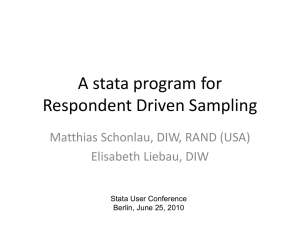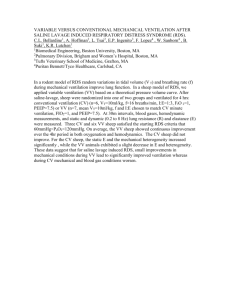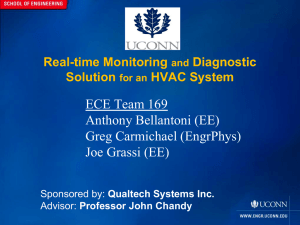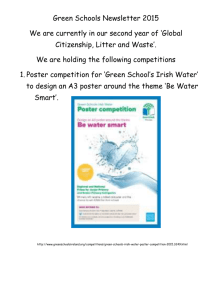RDS 1997 Remedial Investigation Report
advertisement
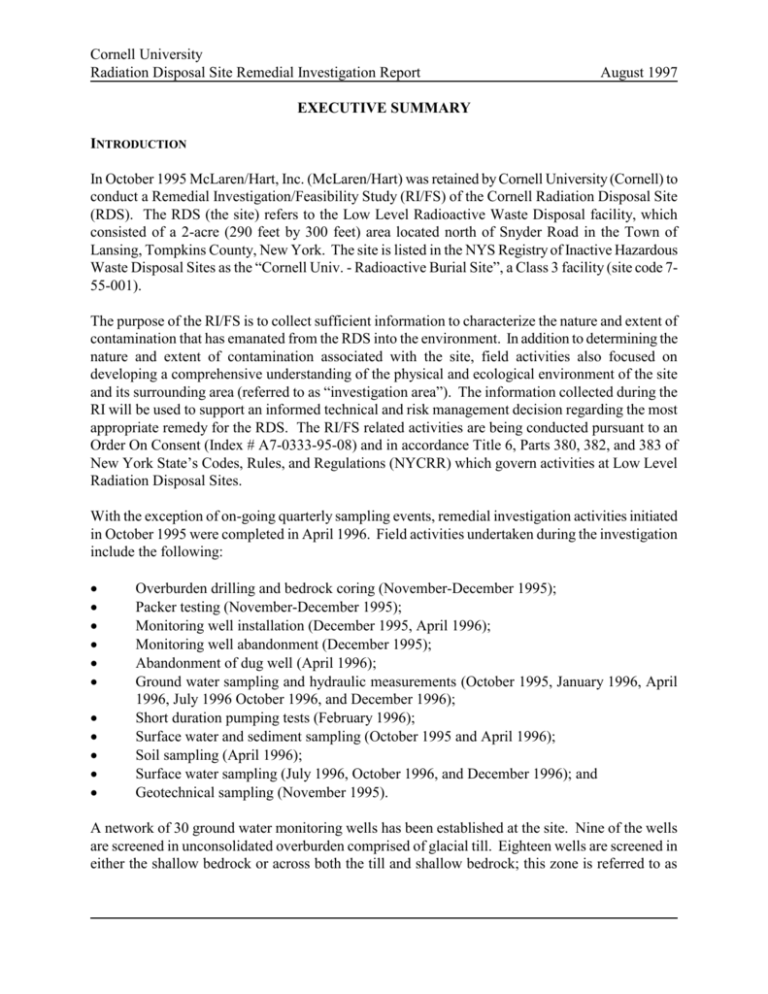
Cornell University Radiation Disposal Site Remedial Investigation Report August 1997 EXECUTIVE SUMMARY INTRODUCTION In October 1995 McLaren/Hart, Inc. (McLaren/Hart) was retained by Cornell University (Cornell) to conduct a Remedial Investigation/Feasibility Study (RI/FS) of the Cornell Radiation Disposal Site (RDS). The RDS (the site) refers to the Low Level Radioactive Waste Disposal facility, which consisted of a 2-acre (290 feet by 300 feet) area located north of Snyder Road in the Town of Lansing, Tompkins County, New York. The site is listed in the NYS Registry of Inactive Hazardous Waste Disposal Sites as the “Cornell Univ. - Radioactive Burial Site”, a Class 3 facility (site code 755-001). The purpose of the RI/FS is to collect sufficient information to characterize the nature and extent of contamination that has emanated from the RDS into the environment. In addition to determining the nature and extent of contamination associated with the site, field activities also focused on developing a comprehensive understanding of the physical and ecological environment of the site and its surrounding area (referred to as “investigation area”). The information collected during the RI will be used to support an informed technical and risk management decision regarding the most appropriate remedy for the RDS. The RI/FS related activities are being conducted pursuant to an Order On Consent (Index # A7-0333-95-08) and in accordance Title 6, Parts 380, 382, and 383 of New York State’s Codes, Rules, and Regulations (NYCRR) which govern activities at Low Level Radiation Disposal Sites. With the exception of on-going quarterly sampling events, remedial investigation activities initiated in October 1995 were completed in April 1996. Field activities undertaken during the investigation include the following: Overburden drilling and bedrock coring (November-December 1995); Packer testing (November-December 1995); Monitoring well installation (December 1995, April 1996); Monitoring well abandonment (December 1995); Abandonment of dug well (April 1996); Ground water sampling and hydraulic measurements (October 1995, January 1996, April 1996, July 1996 October 1996, and December 1996); Short duration pumping tests (February 1996); Surface water and sediment sampling (October 1995 and April 1996); Soil sampling (April 1996); Surface water sampling (July 1996, October 1996, and December 1996); and Geotechnical sampling (November 1995). A network of 30 ground water monitoring wells has been established at the site. Nine of the wells are screened in unconsolidated overburden comprised of glacial till. Eighteen wells are screened in either the shallow bedrock or across both the till and shallow bedrock; this zone is referred to as Cornell University Radiation Disposal Site Remedial Investigation Report August 1997 “interface”. The remaining three monitoring wells are screened into the deeper bedrock that exhibits less fractures than the shallow bedrock. This deeper zone is referred to as “competent bedrock”. SITE BACKGROUND SITE AND SURROUNDING AREA DESCRIPTION Primary access to the site is through a locked twenty-foot sliding gate located on the southwest side of the site. A single lane dirt road from Snyder Road, located approximately 350 feet to the south, provides vehicle access to the entrance of the RDS. A locked twenty-foot sliding gate is located approximately 30 feet north of the Snyder Road entrance to provide additional security. Directly to the north and northeast of the RDS is wooded, undeveloped land containing several areas of Class I and II designated wetlands owned by Cornell University. In this area and to the northwest, contiguous with the wetlands, are two sets of experimental ponds, owned, managed and used by Cornell University's Department of Soil, Crop, and Atmospheric Sciences for various research activities. Approximately one-half mile to the south of the RDS are the northwest-southeast oriented runways of Tompkins County Airport, the closest commercial facility, covering an area of approximately 360 acres. Along the southeastern boundary of the RDS is an undeveloped open field used by Cornell University for research purposes (e.g. goldenrod and insect observation). Along the RDS's southwestern boundary is a plot of fields formerly enclosed by a hexagonal fence line. This plot of land is owned by Cornell University and was used from approximately 1973 to 1977 for rat migration studies. Approximately one-third mile to the southeast of the RDS is Cornell University’s Chemical Disposal Site (CDS). Between 1962 and 1977, Cornell operated the CDS as a landfill for disposal of chemical wastes from the University’s laboratories. Subsequently, the CDS was placed on the New York State Registry of Inactive Hazardous Waste Sites as a Class 2 facility (Site Code 7-55-002). In addition to remedial investigation activities, several Interim Remedial Measures have been conducted to isolate CDS wastes from the environment and public. SITE HISTORY The site was operational beginning 1956 through June 1978 in accordance with regulated procedures in effect at the time. Wastes, including carcasses of animals used in radiation-biology research, were buried in trenches excavated at the site. Carcasses of small animals were placed in drums and boxes prior to burial. Radioactive contaminated laboratory materials, including animal fecal material and dry laboratory waste (e.g. test tubes, absorbent paper, gloves, pipettes) placed in plastic bags, also were deposited at the site. In addition vials containing ‘cocktails’ of chemical solvents (e.g. toluene, alcohols, paradioxane, naphthalene and xylene) used in the scintillation process (i.e., the process used to count radioactive emissions) were also disposed at the RDS. Approximately 255,000 cubic feet (9,400 cubic yards) of low level radioactive waste were buried at the two acre site. Based on the available records on the disposal of material at the RDS, it has been estimated that as of January 1993, approximately 1.1 curies of carbon-14 and 5.5 curies of tritium, in addition to 12 Cornell University Radiation Disposal Site Remedial Investigation Report August 1997 millicuries of strontium-90 (90Sr ) and 95 millicuries of cesium-137 (137Cs) and lesser amounts of other radioisotopes remain at the site. In September 1996, an Interim Remedial Measure (IRM) was initiated. As part of the IRM, the RDS was cleared of vegetative growth and a high density polyethylene (HDPE) liner was placed over the area to prevent surface water from penetrating the potentially contaminated soil and conveying contaminants to the public. To protect public welfare and prevent wildlife from entering the area, an 8-foot chain link fence topped with three (3) strands of barbed wire was constructed around the site approximately 60 feet from the perimeter of the RDS. A conveyance line was installed to transport contaminated waste water collected from ground water monitoring activities to the Chemical Disposal Site (CDS) located approximately one-third mile to the southeast of the RDS. Also as part of the IRM, in addition to these activities, electrical service was supplied to the site and a tile drain investigation was performed to locate potential areas of extreme groundwater migration. The initial IRM of the RDS was substantially complete by November 25, 1996. PREVIOUS INVESTIGATIONS AND FINDINGS Since 1984, phased field investigations at the RDS were conducted by E&E and by Dames & Moore. The site investigations included the following activities: Installation of twenty-two monitoring wells; Overland gamma survey; Surface soil and vegetation sampling and analysis; Direct beta radiation survey; Periodic ground water sampling and analysis; and Surface water sampling and analysis. In 1984 E&E began site investigation activities with the installation of four monitoring wells to assess ground water quality and flow direction. In 1993 Dames & Moore initiated field activities associated with a preliminary assessment of the RDS. Characterization activities at the RDS involved surface soil and vegetation sampling within the RDS source area, surface water sampling upgradient and downgradient of the RDS, and the installation and sampling of monitoring wells to assess ground water quality. The investigations conducted by E&E and by Dames and Moore included the analysis of site media for volatile organic compounds (VOCs), including paradioxane, pesticides, polychlorinated biphenyls (PCBs), semivolatile organic compounds (SVOCs), and radiological activity, as measured by gross alpha, gross beta, 14C, 137Cs, 90Sr , tritium, and gamma spectrometry analyses. Additional investigations of surface water were performed by NYSDEC and NYSDOH as part of a New York State Environmental Radiation Surveillance Program. NYSDEC conducted radiological sampling of surface water in the vicinity of the RDS between 1974 and 1981. Since 1982 NYSDOH has been responsible for the sampling in the area of Tompkins County and the RDS. These Cornell University Radiation Disposal Site Remedial Investigation Report August 1997 investigations involved the sampling of surface water for radiological analysis at locations proximal to the RDS, as well as downgradient locations towards Cayuga Lake. Concentrations of radionuclides were elevated with respect to background concentrations in some vegetation and soil samples collected within the fenced-in area of the RDS and in ground water samples collected adjacent to the RDS. Of the VOCs, benzene and cis-1,2-dichloroethene (DCE), and paradioxane were detected at elevated concentrations in ground water samples. Paradioxane was also detected in surface water samples and in 1 sediment sample. Radionuclides, paradioxane, DCE and benzene were considered compounds of concern in ground water, in addition to paradioxane in surface water. The sampling activities through 1995 indicated that radiologic compounds were impacting vegetation and soil within the fenced-in area, and ground water adjacent to the RDS. The compounds paradioxane, DCE and benzene were also impacting ground water and only paradioxane was detected in surface water and 1 sediment sample. CONCEPTUAL MODEL Prior to installation of the temporary cap on the RDS, potential exposure points were associated with all the affected media: air; vegetation; soil; surface water/sediment; and ground water. After completion of the cap, affected media within the source area (air; vegetation; soil) were eliminated as exposure points and pathways for transport of contaminants. Possible receptors of impacted surface water are off-site workers, researchers, and people taking part in recreational activities, via dermal contact or ingestion. Aquatic wildlife and the wetland ecosystem could be impacted by bioconcentration of contaminants in body or plant tissue or by ingestion. Secondary receptors would include people who consume fish or wildlife. Potential receptors of impacted ground water include people with residential and commercial wells located in a downgradient direction from the site. Based on the conceptual site model, remedial investigation activities were implemented to further evaluate impacts to ground water and surface water resulting from the RDS. PHYSICAL AND ECOLOGICAL CHARACTERISTICS PHYSICAL SETTING The site lies in south-central New York State and is within the Allegheny Synclinorium part of the Appalachian Plateau physiographic province. Cayuga Lake, one of the Finger Lakes, is located approximately 3 miles to the west of the RDS. The RDS has an elevation of approximately 1120 feet above sea level. The land therefore has a slope to the west at generally 250 feet per mile between Cayuga Lake and the RDS area. Water bodies within the vicinity of the RDS area eventually flow into Cayuga Lake. Topographically, the investigation area is rolling in nature, with the RDS located on a knoll. The site is adjacent to a shallow valley drained by an intermittent stream that flows under Snyder Cornell University Radiation Disposal Site Remedial Investigation Report August 1997 road and across the Tompkins County Airport property. The stream is fed by a man-made pond located at the eastern end of the investigation area. The site is underlain by a relatively thin veneer (less than 30 feet) of glacial till that lies unconformably atop Upper Devonian aged Genesee Formation, a dark gray shale. Ground water has been observed in the glacial till and the underlying shale. Both the glacial till and shale exhibit low hydraulic conductivities (i.e., transmit water poorly). The bedrock is more fractured at its surface and within the upper 10 feet. The fractures in the rock lessen with depth and hence so does the water-bearing capacity. Horizontal ground water flow direction within the glacial till is westerly, and in the highly fractured shale unit it is southwesterly at the RDS. Artesian flow conditions were observed in airport monitoring wells. The horizontal ground water flow direction in the competent bedrock has been difficult to assess because only three wells are available for triangulation. ECOLOGICAL SETTING The investigation area and the surrounding vicinity are characterized from an ecological perspective by a variety of vegetative communities, both terrestrial, wetland and aquatic. These communities, which area defined as a variable assemblage of interacting plants and animals living in a common environment, show varying degrees of human disturbance. In general, communities are distinguished by physiognomy, composition of resident species, and ecological processes. These communities range from mature second-growth forests to cleared fields exhibiting secondary succession. SUMMARY OF NATURE AND EXTENT OF CONTAMINATION GROUND WATER Compounds of concern include radionuclides, paradioxane, DCE and benzene. Strontium-90 levels measured in downgradient sampling wells located next to the site have been at or slightly above the ground water standard of 8 pCi/L. Further downgradient ground water concentrations within the till/shallow bedrock interface and bedrock units have been consistently below state and federal water standards , and at or below background levels. Tritium levels for all water samples have consistently been below water quality standards and in many cases at or below background. Paradioxane due to its prevalence, distribution and concentrations of detections is the contaminant of most concern. Besides paradioxane, other VOCs were detected in ground water, and include: acetone, benzene, carbon disulfide, chloroform, cis and trans dichloroethene (DCE), ethyl ether, methylene chloride, trichloroethene, and trimethylbenzene. Of these 10 VOCs (not including paradioxane), trichloroethylene, trimethylbenzene, methylene chloride, and chloroform were detected in wells south of Snyder Road. Only cis 1,2 DCE, ethyl ether, and benzene were observed during the Cornell University Radiation Disposal Site Remedial Investigation Report August 1997 RI above NYSDEC standards. These compounds are reported only slightly above the limit and in wells north of Snyder Road (i.e., these constituents have not migrated appreciably). SURFACE WATER The only contaminant observed in surface water is paradioxane. The downgradient-most detection of paradioxane in surface water was encountered at the SW-33 sampling location, in a drainage ditch along the east side of Warren Road. The highest detections of paradioxane in surface water were encountered on the airport property. The detections in surface water will require additional sampling to further evaluate if the source of these detections could be attributed to base flow of ground water to surface water, or if the detections could be related to runoff from the RDS or CDS. SEDIMENT As part of the remedial investigation, sediment samples were collected in October 1995 and April 1996. Only paradioxane was detected in one sediment sample (SED-10) at a concentration of 59 ppb in April 1996. Based on the limited detections and limited adsorptive properties of paradioxane, as well as the intermittent nature of surface water flow in the area of the RDS, no further sampling of sediment is proposed in the RDS Monitoring Plan, submitted concurrently with this report. CONCLUSIONS AND RECOMMENDATIONS The primary contaminant of concern associated with the RDS is paradioxane, detected in ground water and surface water. The source of these detections is waste material that was buried over a period of 20 years in thin linear trenches at the RDS. Concentrations of radiological compounds in soils, sediment, vegetation and ground water samples collected on-site or in wells closest to the RDS indicated detections above background concentrations. However, measured concentrations in ground water and surface water have been consistently below levels of concern and do not pose a health threat to surrounding public communities or site visitors. Sampling for additional radiological compounds is proposed in the RDS Monitoring Plan and Supplemental RI to confirm previous sampling results and/or to monitor long-term conditions. The lateral and vertical extent of paradioxane in ground water has not been fully delineated to nondetectable concentrations. Additional bedrock well installation is proposed as part of the Supplemental RI to determine ground water flow direction in the deep bedrock, and to provide additional monitoring points at locations upgradient and downgradient of the site. Future quarterly sampling of ground water will serve to evaluate plume migration and confirm that the deep bedrock has not been impacted by elevated concentrations of paradioxane. A well survey is also proposed to evaluate if impacted ground water migrating from the RDS could potentially impact users of ground water downgradient of the site. Cornell University Radiation Disposal Site Remedial Investigation Report August 1997 It is possible that ground water may be discharging to surface water in the area of the airport, based on artesian flow conditions observed in two airport monitoring wells. Another source could be related to the CDS. Future sampling events will include attempts to collect ground water and surface water samples at the same location on the airport. Surface water samples will also be collected in areas around the CDS discharge pond to assess if a source of surface water detections could be related to the CDS. Provisions for collection of field-determined samples will also be included in future sampling programs to accommodate evaluation of ground water seeps at other locations on the airport within the area of the ground water plume.
